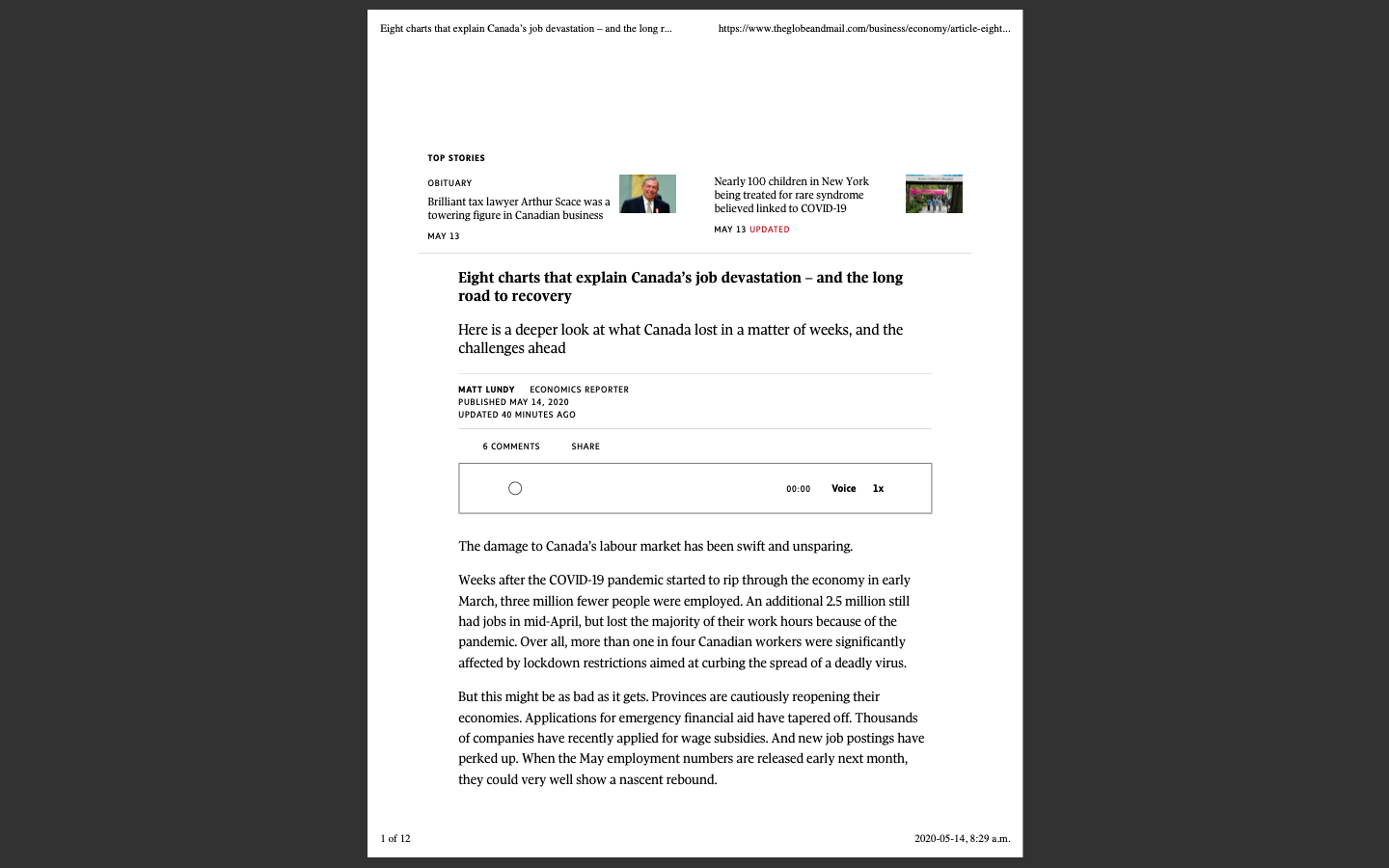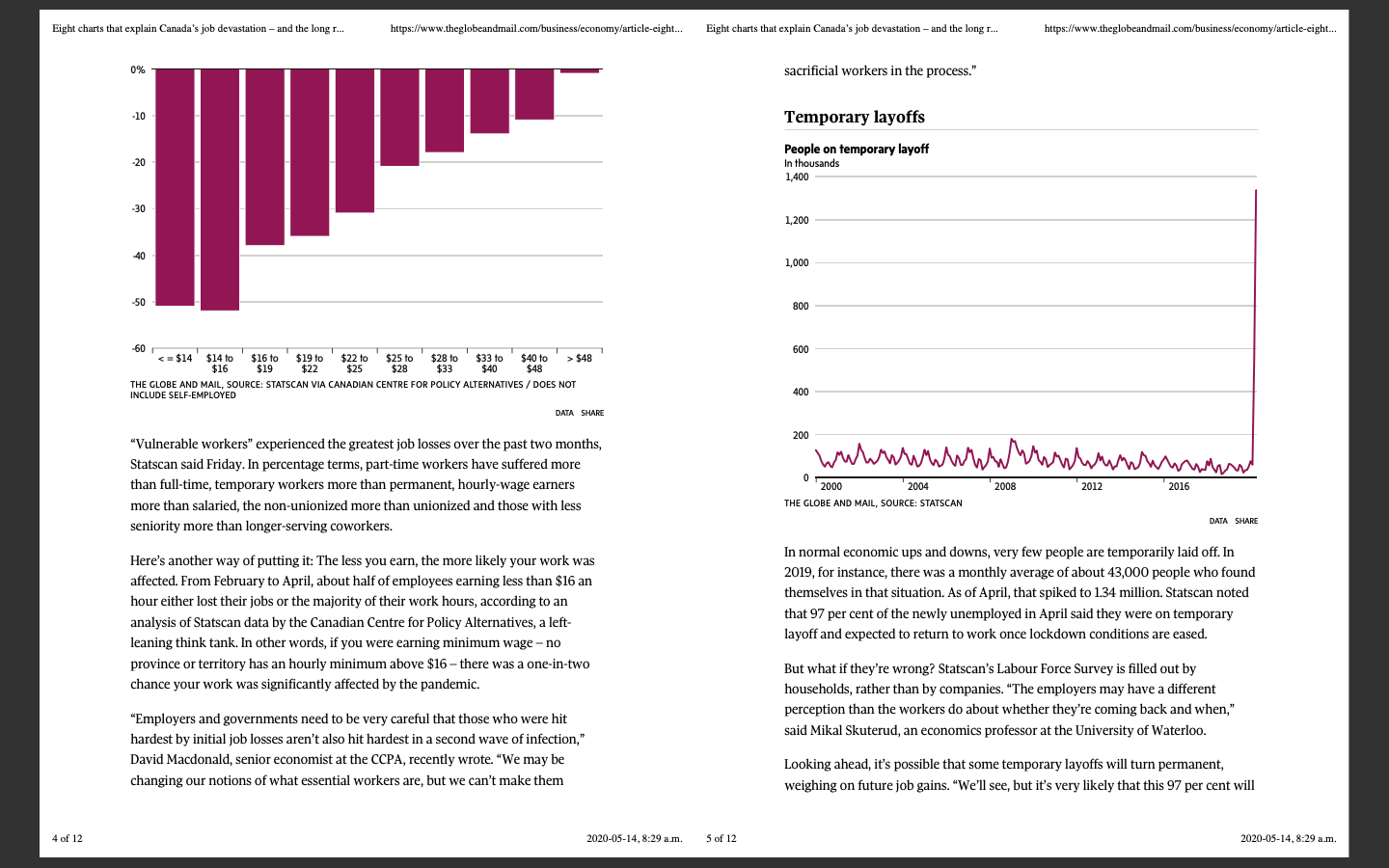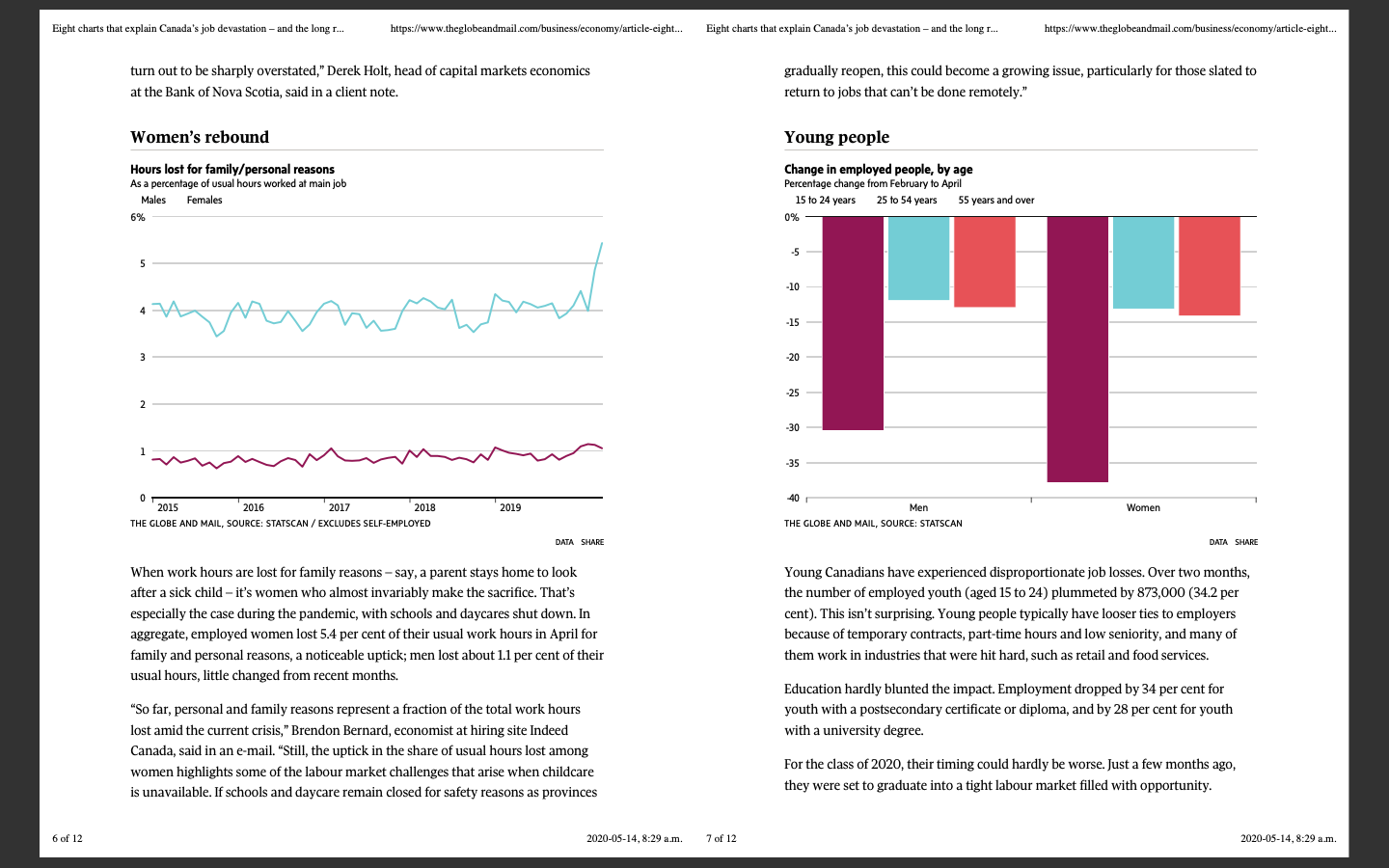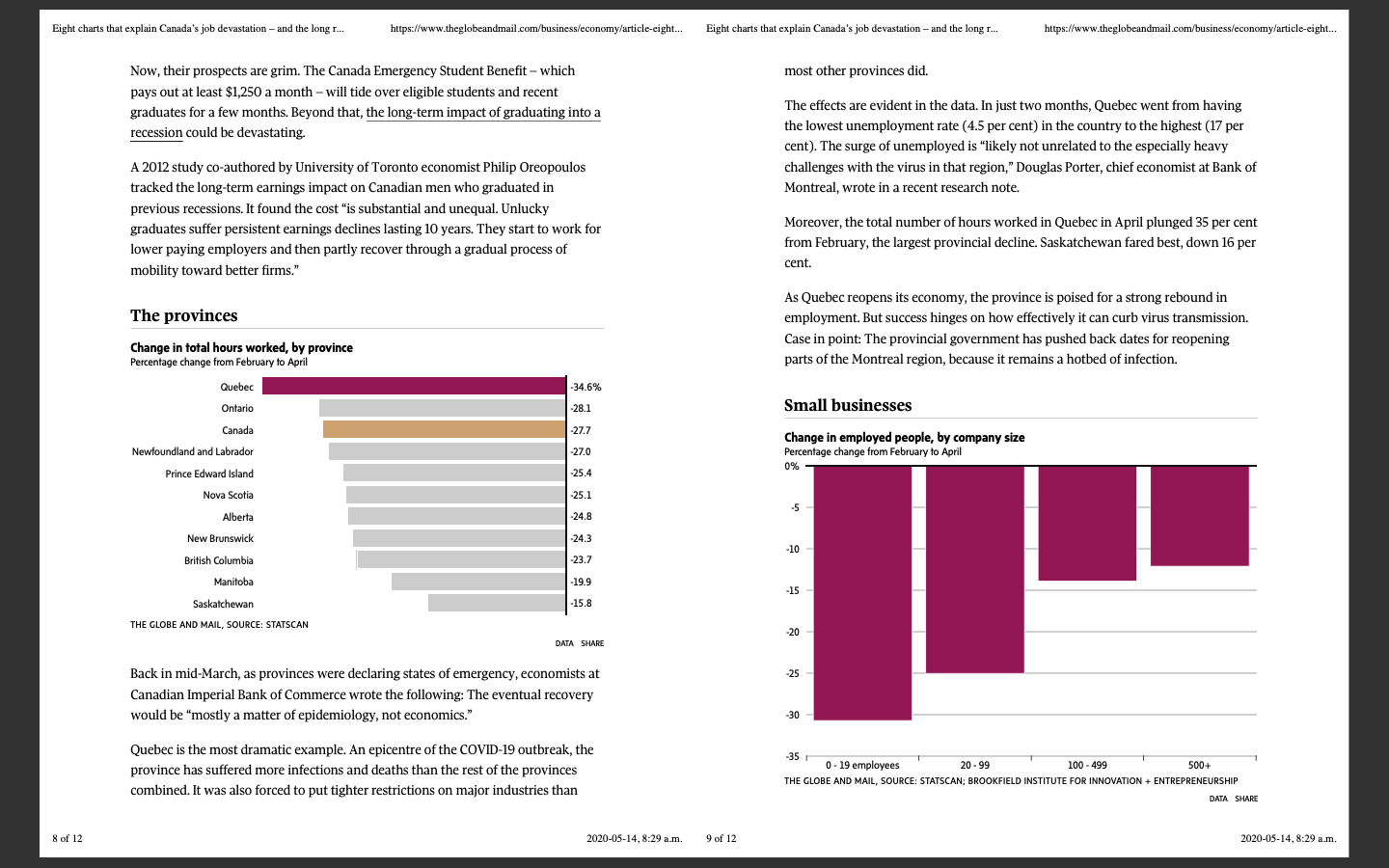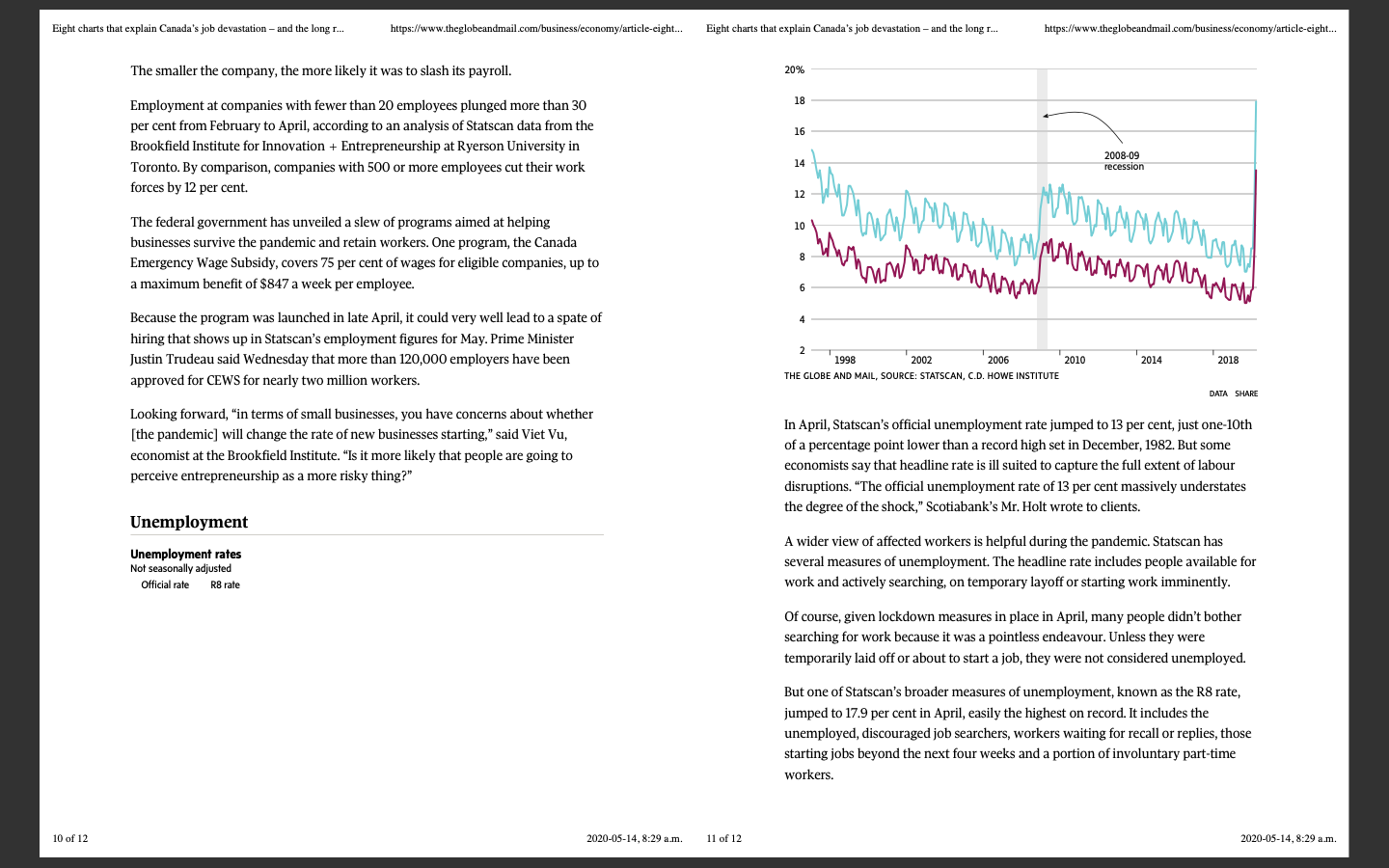Are there any policy implications of the changes highlighted in the article?
Eight charts that explain Canada's job devastation - and the long r... https://www.theglobeandmail.com/business/economy/article-eight... TOP STORIES OBITUARY Nearly 100 children in New York Brilliant tax lawyer Arthur Scace was a being treated for rare syndrome towering figure in Canadian business believed linked to COVID-19 MAY 13 MAY 13 UPDATED Eight charts that explain Canada's job devastation - and the long road to recovery Here is a deeper look at what Canada lost in a matter of weeks, and the challenges ahead MATT LUNDY ECONOMICS REPORTER PUBLISHED MAY 14, 2020 UPDATED 40 MINUTES AGO 6 COMMENTS SHARE O 00:00 Voice 1x The damage to Canada's labour market has been swift and unsparing. Weeks after the COVID-19 pandemic started to rip through the economy in early March, three million fewer people were employed. An additional 2.5 million still had jobs in mid-April, but lost the majority of their work hours because of the pandemic. Over all, more than one in four Canadian workers were significantly affected by lockdown restrictions aimed at curbing the spread of a deadly virus. But this might be as bad as it gets. Provinces are cautiously reopening their economies. Applications for emergency financial aid have tapered off. Thousands of companies have recently applied for wage subsidies. And new job postings have perked up. When the May employment numbers are released early next month, they could very well show a nascent rebound. 1 of 12 2020-05-14, 8:29 a.m.Eight charts that explain Canada's job devastation - and the long r... https://www.theglobeandmail.com/business/economy/article-eight... Eight charts that explain Canada's job devastation - and the long r... https://www.theglobeandmail.com/business/economy/article-eight... "Given the shock we're dealing with, we should be careful not to be too optimistic, early 1980s and 90s, it took an average of more than six years for goods-sector but we can at least start to have a bit of hope that the worst may be behind us," employment to return to prerecession levels, Statistics Canada said last Friday. After Brian DePratto, senior economist at Toronto-Dominion Bank, said in a recent client the 2008-09 global financial crisis, it took 10 years for goods-sector jobs to fully note. return. In those downturns, services jobs bounced back in an average of four Undoubtedly, it will take longer to recoup jobs than it did to destroy them. Some months. industries are nowhere near a return. Moreover, plans for reopening could get This time around, job losses have been widespread by industry. From February to derailed by a second wave of infections that some epidemiologists fear is inevitable. April, goods-sector employment dropped by 16.8 per cent and services employment But for now, we're starting to pick up the pieces. Here is a deeper look at what by 15.4 per cent, both worse than in the previous three recessions. Canada lost in a matter of weeks, and the challenges ahead. What's clear is that The recovery, however, could play out very differently. As provinces begin to labour destruction was not evenly felt. The recovery won't be either. reopen, certain service industries in which close physical contact is necessary - say, restaurant and retail work - will remain heavily restricted or shut down. The industry rebound Meanwhile, construction and other goods-producing sectors are starting to ramp back up. Employment decline by recession In thousands of people Goods-producing sector Services-producing sector "Things like construction, and even some manufacturing, tend to be more male- 500 dominated jobs, [and] those jobs will be able to come back quickly," said Tammy Schirle, an economics professor at Wilfrid Laurier University. Dr. Schirle is "very concerned" that service-sector jobs will struggle to recoup their losses quickly, especially in industries in which female representation is high. .500 The vulnerable 1,000 Jobs or majority of hours lost, by hourly wage decile Percentage change from February to April -1,500 -2,000 -2,500 1981 - 1982 recession 1990 - 1992 recession 2008 - 2009 recession COVID-19 downturn THE GLOBE AND MAIL, SOURCE: STATSCAN DATA SHARE In past recessions, Canada's goods-producing sector bore the brunt of job losses. Making matters worse, the recovery process was sluggish. After recessions in the 2 of 12 2020-05-14, 8:29 a.m. 3 of 12 2020-05-14, 8:29 a.m.Eight charts that explain Canada's job devastation - and the long r... https://www.theglobeandmail.com/business/economy/article-eight... Eight charts that explain Canada's job devastation - and the long r... https://www.theglobeandmail.com/business/economy/article-eight... 0% sacrificial workers in the process." 10 Temporary layoffs People on temporary layoff -20 In thousands 1,400 1,200 AO 1,000 50 800 60 $48 600 $16 $19 $22 $28 to $33 to $40 to $25 $28 $33 $40 $48 THE GLOBE AND MAIL, SOURCE: STATSCAN VIA CANADIAN CENTRE FOR POLICY ALTERNATIVES / DOES NOT INCLUDE SELF-EMPLOYED 400 DATA SHARE "Vulnerable workers" experienced the greatest job losses over the past two months, 200 Statscan said Friday. In percentage terms, part-time workers have suffered more than full-time, temporary workers more than permanent, hourly-wage earners 2000 2004 2008 2012 2016 more than salaried, the non-unionized more than unionized and those with less THE GLOBE AND MAIL, SOURCE: STATSCAN seniority more than longer-serving coworkers. DATA SHARE Here's another way of putting it: The less you earn, the more likely your work was In normal economic ups and downs, very few people are temporarily laid off. In affected. From February to April, about half of employees earning less than $16 an 2019, for instance, there was a monthly average of about 43,000 people who found hour either lost their jobs or the majority of their work hours, according to an themselves in that situation. As of April, that spiked to 1.34 million. Statscan noted analysis of Statscan data by the Canadian Centre for Policy Alternatives, a left- that 97 per cent of the newly unemployed in April said they were on temporary leaning think tank. In other words, if you were earning minimum wage - no layoff and expected to return to work once lockdown conditions are eased. province or territory has an hourly minimum above $16 - there was a one-in-two But what if they're wrong? Statscan's Labour Force Survey is filled out by chance your work was significantly affected by the pandemic. households, rather than by companies. "The employers may have a different "Employers and governments need to be very careful that those who were hit perception than the workers do about whether they're coming back and when," hardest by initial job losses aren't also hit hardest in a second wave of infection," said Mikal Skuterud, an economics professor at the University of Waterloo. David Macdonald, senior economist at the CCPA, recently wrote. "We may be Looking ahead, it's possible that some temporary layoffs will turn permanent, changing our notions of what essential workers are, but we can't make them weighing on future job gains. "We'll see, but it's very likely that this 97 per cent will 4 of 12 2020-05-14, 8:29 a.m. 5 of 12 2020-05-14, 8:29 a.m.Eight charts that explain Canada's job devastation - and the long r.. https://www.theglobeandmail.com/business/economy/article-eight... Eight charts that explain Canada's job devastation - and the long r... https://www.theglobeandmail.com/business/economy/article-eight... turn out to be sharply overstated," Derek Holt, head of capital markets economics gradually reopen, this could become a growing issue, particularly for those slated to at the Bank of Nova Scotia, said in a client note. return to jobs that can't be done remotely." Women's rebound Young people Hours lost for family/personal reasons Change in employed people, by age As a percentage of usual hours worked at main job Percentage change from February to April Males Females 15 to 24 years 25 to 54 years 55 years and over 6% 0% 5 -10 -15 N -25 -30 -35 9015 2016 2017 2018 2019 40 Men Women THE GLOBE AND MAIL, SOURCE: STATSCAN / EXCLUDES SELF-EMPLOYED THE GLOBE AND MAIL, SOURCE: STATSCAN DATA SHARE DATA SHARE When work hours are lost for family reasons - say, a parent stays home to look Young Canadians have experienced disproportionate job losses. Over two months, after a sick child - it's women who almost invariably make the sacrifice. That's the number of employed youth (aged 15 to 24) plummeted by 873,000 (34.2 per especially the case during the pandemic, with schools and daycares shut down. In cent). This isn't surprising. Young people typically have looser ties to employers aggregate, employed women lost 5.4 per cent of their usual work hours in April for because of temporary contracts, part-time hours and low seniority, and many of family and personal reasons, a noticeable uptick; men lost about 1.1 per cent of their them work in industries that were hit hard, such as retail and food services. usual hours, little changed from recent months. Education hardly blunted the impact. Employment dropped by 34 per cent for "So far, personal and family reasons represent a fraction of the total work hours youth with a postsecondary certificate or diploma, and by 28 per cent for youth lost amid the current crisis," Brendon Bernard, economist at hiring site Indeed with a university degree. Canada, said in an e-mail. "Still, the uptick in the share of usual hours lost among women highlights some of the labour market challenges that arise when childcare For the class of 2020, their timing could hardly be worse. Just a few months ago, is unavailable. If schools and daycare remain closed for safety reasons as provinces they were set to graduate into a tight labour market filled with opportunity. 6 of 12 2020-05-14, 8:29 a.m. 7 of 12 2020-05-14, 8:29 a.m.Eight charts that explain Canada's job devastation - and the long r... https://www.theglobeandmail.com/business/economy/article-eight... Eight charts that explain Canada's job devastation - and the long r... https://www.theglobeandmail.com/business/economy/article-eight... Now, their prospects are grim. The Canada Emergency Student Benefit - which most other provinces did. pays out at least $1,250 a month - will tide over eligible students and recent graduates for a few months. Beyond that, the long-term impact of graduating into a The effects are evident in the data. In just two months, Quebec went from having recession could be devastating. the lowest unemployment rate (4.5 per cent) in the country to the highest (17 per cent). The surge of unemployed is "likely not unrelated to the especially heavy A 2012 study co-authored by University of Toronto economist Philip Oreopoulos challenges with the virus in that region," Douglas Porter, chief economist at Bank of tracked the long-term earnings impact on Canadian men who graduated in Montreal, wrote in a recent research note. previous recessions. It found the cost "is substantial and unequal. Unlucky graduates suffer persistent earnings declines lasting 10 years. They start to work for Moreover, the total number of hours worked in Quebec in April plunged 35 per cent lower paying employers and then partly recover through a gradual process of from February, the largest provincial decline. Saskatchewan fared best, down 16 per mobility toward better firms." ent. As Quebec reopens its economy, the province is poised for a strong rebound in The provinces employment. But success hinges on how effectively it can curb virus transmission. Change in total hours worked, by province Case in point: The provincial government has pushed back dates for reopening Percentage change from February to April parts of the Montreal region, because it remains a hotbed of infection. Quebec -34.6% Ontario -28.1 Small businesses Canada -27.7 Change in employed people, by company size Newfoundland and Labrador -27.0 Percentage change from February to April Prince Edward Island -25.4 0% Nova Scotia -25.1 Alberta -24.8 New Brunswick -24.3 British Columbia -23.7 Manitoba -19.9 .15 Saskatchewan -15.8 THE GLOBE AND MAIL, SOURCE: STATSCAN $20 DATA SHARE Back in mid-March, as provinces were declaring states of emergency, economists at -25 Canadian Imperial Bank of Commerce wrote the following: The eventual recovery would be "mostly a matter of epidemiology, not economics." -30 Quebec is the most dramatic example. An epicentre of the COVID-19 outbreak, the -35 province has suffered more infections and deaths than the rest of the provinces 0 - 19 employees 20 - 99 100 - 499 500+ combined. It was also forced to put tighter restrictions on major industries than THE GLOBE AND MAIL, SOURCE: STATSCAN; BROOKFIELD INSTITUTE FOR INNOVATION + ENTREPRENEURSHIP DATA SHARE 8 of 12 2020-05-14, 8:29 a.m. 9 of 12 2020-05-14, 8:29 a.m.Eight charts that explain Canada's job devastation - and the long r... https://www.theglobeandmail.com/business/economy/article-eight... Eight charts that explain Canada's job devastation - and the long r... https://www.theglobeandmail.com/business/economy/article-eight... The smaller the company, the more likely it was to slash its payroll. 20% Employment at companies with fewer than 20 employees plunged more than 30 18 per cent from February to April, according to an analysis of Statscan data from the 16 Brookfield Institute for Innovation + Entrepreneurship at Ryerson University in Toronto. By comparison, companies with 500 or more employees cut their work 14 2008-09 recession forces by 12 per cent. 12 The federal government has unveiled a slew of programs aimed at helping businesses survive the pandemic and retain workers. One program, the Canada 10 Emergency Wage Subsidy, covers 75 per cent of wages for eligible companies, up to 8 - a maximum benefit of $847 a week per employee. 6 Because the program was launched in late April, it could very well lead to a spate of 4 hiring that shows up in Statscan's employment figures for May. Prime Minister Justin Trudeau said Wednesday that more than 120,000 employers have been 2 - 1998 2002 2006 2010 2014 2018 approved for CEWS for nearly two million workers. THE GLOBE AND MAIL, SOURCE: STATSCAN, C.D. HOWE INSTITUTE DATA SHARE Looking forward, "in terms of small businesses, you have concerns about whether [the pandemic] will change the rate of new businesses starting," said Viet Vu, In April, Statscan's official unemployment rate jumped to 13 per cent, just one-10th economist at the Brookfield Institute. "Is it more likely that people are going to of a percentage point lower than a record high set in December, 1982. But some perceive entrepreneurship as a more risky thing?" economists say that headline rate is ill suited to capture the full extent of labour disruptions. "The official unemployment rate of 13 per cent massively understates Unemployment the degree of the shock," Scotiabank's Mr. Holt wrote to clients. Unemployment rates A wider view of affected workers is helpful during the pandemic. Statscan has Not seasonally adjusted several measures of unemployment. The headline rate includes people available for Official rate R8 rate work and actively searching, on temporary layoff or starting work imminently. Of course, given lockdown measures in place in April, many people didn't bother searching for work because it was a pointless endeavour. Unless they were temporarily laid off or about to start a job, they were not considered unemployed. But one of Statscan's broader measures of unemployment, known as the R8 rate, jumped to 17.9 per cent in April, easily the highest on record. It includes the unemployed, discouraged job searchers, workers waiting for recall or replies, those starting jobs beyond the next four weeks and a portion of involuntary part-time workers. 10 of 12 2020-05-14, 8:29 a.m. 11 of 12 2020-05-14, 8:29 a.m.Eight charts that explain Canada's job devastation - and the long r.. https://www.theglobeandmail.com/business/economy/article-eight... As of April, about 1.5 million people were not in the labour force - that is, they weren't employed or looking for jobs - but still wanted work, an increase of 1.1 million from February. Look for this figure to drop significantly in the months ahead as the hiring climate improves. Your time is valuable. Have the Top Business Headlines newsletter conveniently delivered to your inbox in the morning or evening. Sign up today. Copyright 2020 The Globe and Mail Inc. All rights reserved. 351 King Street East, Suite 1600, Toronto, ON Canada, MSA ON1 Phillip Crawley, Publisher 12 of 12 2020-05-14, 8:29 a.m
